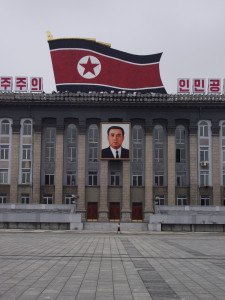Fueling Tensions at North Korea’s Worker’s Party Foundation Ceremony
Concerns over a possible North Korean missile launch have been dismissed after North Korea carried out its 70th anniversary of the Worker’s Party in a relatively peaceful manner. The anniversary included a traditional military parade and a rare public speech by supreme leader Kim Jong Un. This year’s anniversary stood in sharp contrast with those of previous years, in which North Korea often launched missiles and displayed nuclear warheads in the parade, fueling hostility with neighboring countries.

North Korea did not reveal any new weapons in its military parade this year. The only noteworthy weapon displayed was the KN-08 ICBM missile that appeared in previous years, which is capable of striking the U.S. mainland with its range of 12,000 kilometers. North Korean state media claimed that these missiles were equipped with miniaturized nuclear warheads, but South Korean military experts have denied such claims.
“It is a copy of a Chinese multiple rocket launcher, which is in the last stage of development,”an anonymous South Korean military official said. “We believe it has a maximum range of around 140 kilometers.”
Although North Korea displayed its military power at the parade, this year’s celebration was conservative compared to past ones. A possible explanation is that North Korea utilized this anniversary to improve its relationship with China and shift its national priorities. Sino-North Korean relationships have deteriorated since North Korea’s third nuclear test and Kim’s unprecedented purge of his closest officials in 2013. The only foreign dignitary in attendance was Liu Yunshan, who ranks fifth in the Chinese Communist Party. The two officials met prior to the parade, where Liu affirmed China’s stance against North Korea’s nuclear program as well as China’s intentions to resume six-party talks regarding the matter.
Despite the ostentatious display of North Korea’s military prowess, there was no mention of nuclear weapons in Kim Jong Un’s speech. According to a report from South Korea’ Ministry of Reunification, the most frequently used word in the speech was “people.” Thus, the report concluded that the Kim Jong Un’s speech emphasized “the love of the people centering around a concept of ‘prioritizing the people.’”
Yang Mu Jin, a professor at University of North Korean Studies, commented, “If the previous Kim Il Sung regime revolved around ‘party-first’ politics and the Kim Jong Il regime revolved around ‘military-first’ politics, the current Kim Jong Un regime is transitioning into ‘people-first’ politics in order to direct the national priority to improving the well-being of their citizens.”
However, this possible shift in North Korea’s strategy may not be interpreted as a shift in their relationship with United States, as Kim still relied on long-recurring anti-American rhetoric to earn the crowd’s support.
“Our revolutionary forces are capable of dealing with any kind of war being waged by the U.S.,” Kim said. “The U.S. has pushed for terrible wars and is posing new threats of aggression … It has also stood in the way of us with unprecedented sanctions and blockades if we intended to develop our economy.”
